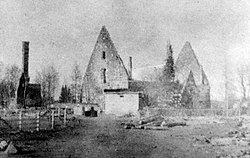Great Purification
| Great Purification | |
|---|---|
| Part of Kæra Genocides | |
 Rural Meeting house in a Ry'uk set alight by Kæra volunteers, 1920 | |
| Location | Kæra'zna |
| Date | 1918-1921 |
| Target | Occupational forces, Zreiru'at sympathizers |
Attack type | |
| Deaths | 8,700 reported |
| Perpetrators | Kærtsæ Tsøka'fla, Cult of Absolute Purity (Azy'uþ Tsøka'sa, Oslu'dy Øfesak'fa) and others |
| Assailants | National Collective Forces, Sanitation Forces |
| Motive | Consolidation of power Revenge Azraic supremacy Restoring the monopoly on violence |
The Great Purification, also known as the Grey Wrath was a Kæra campaign to eradicate and take revenge upon those responsible for the occupation of Kæra'zna by Zreiru'a during the Great War. The campaign was primarily planned by members of the Cult of Absolute Purity, with Oslu'dy Øfesak'fa believed to be the primary architect. Shortly following the capture of Zhar'osyk in February 1918, Zhanyl Kærtsæ Tsøka'fla signed off on the plan's enactment to begin the next month, with the additional goal of securing herself as the sole executor of the state.
Within the Borean theatre of the Great War, the Kæra Collective Republic had sided with the Imperial Powers due to the political pressure placed upon it by Zreiru'a. Despite this, Kæra'zna was invaded by Zreiru'at and Morstopackian forces shortly following an unprovoked declaration of war on 9 November, 1914. The war, a result of the irredentist ambitions of Elwin Arachne, saw a two year long campaign of guerrilla warfare and violent resistance from both military and civilian forces. By June 1916, the country was governed under the Kæra Occupational Authority, which was tasked with the pacification and gradual assimilation of the population through means of violent suppression of Kæra culture and, eventually, the Kæzhyn language.
As such, in the atmosphere of heavy Kæra-Zreiru'at animosity, the regions liberated by rebel forces began to undergo a series of clandestine, unsanctioned mass killings of suspected collaborators and people accused of having sympathies towards the previously instated military regime. While the Kæra government-in-exile did not officially decry the violent reprisals undertaken by civilians, concerns were raised behind closed doors on the body's ability to control the population in the wake of the collapse of Zreiru'at authority in 1918. As such, plans were drawn up to satisfy popular desires for revenge through the organization of an organized campaign designed to root out "the Z'rei and their associates".
After three years of organized mass killings and the execution of suspected sympathizers without trial, the campaign was declared an "unambiguous success" by Kærtsæ Tsøka'fla. Approximately 8,700 deaths of suspected sympathizers were reported during the period. though the actual amount killed is subject to debate due to the presumably high number of unreported deaths performed by members of the Sanitation Forces or done as vigilante action by citizens.
Efforts were made to shift further blame towards the actions of foreign powers - both in the unjustified invasion of Kæra'zna and the recognition of Zreiru'at gains in the 1917 Peace Conference. Such rhetoric was foundational in the assortment of the Closed Door policy, which enacted a system of closed borders - prohibiting the movement of people, as well as further limiting the scale of diplomatic agreements the country is willing to sign onto.